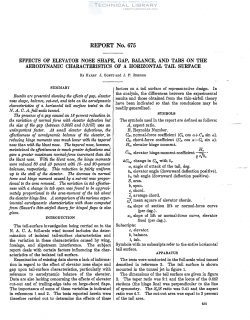naca-report-675

- Version
- 200 Downloads
- 984.10 KB File Size
- 1 File Count
- August 30, 2016 Create Date
- August 30, 2016 Last Updated
National Advisory Committee for Aeronautics, Report - Effects of Elevator Nose Shape, Gap, Balance, and Tabs on the Aerodynamic Characteristics of a Horizontal Tail Surface

Results are presented showing the ejects of gap, elevator
nose shape, balance, cut-out, and tabs on the aerodynamic
characteristics of a horizontal tail surface tested in the
N. A. C. A.full—scale tunnel.
The presence of a gap caused an 18 percent reduction in
the mriation of normal force with elecator deflection but
the size of the gap (between 0.0055 and 0.0103) was an
unimportant factor. At small elemtor deflections, the
efectioeness of aerodynamic balance of the elevator, in
reducing hinge moments was much lower with the tapered
nose than with the blunt nose. The tapered nose, however,
maintained its efectioe-ness to much greater deflections and
gate a greater maximum normal-fine increment than did
the blunt nose. With the blunt nose, the hinge moments
were reduced 30 and 40 percent with 10- and 20-percent
balances, respectively. This reduction is fairly uniform
up to the stall of the elevator. The decrease in normal
force and hinge moment caused by a cut—out was propor—
tional to the area removed. The variation in tab efiectire—
ness with a change in tab span was found to be apprort
mately proportional to the area-moment of the tab about
the elevator hinge line. A comparison of the various exper-
imental aerodynamic characteristics with those computed
from Glauert’s thin—airfoil theory for hinged flaps is also
given.
The tail-surface investigation being carried on in the
N. A. C. A. full-scale wind tunnel includes the deter-
mination of isolated tail-surface characteristics and
the variation in these characteristics caused by Wing,
fuselage, and slipstream interference. The subject
report deals with certain factors influencing the char
acteristics of the isolated tail surface.
Examination of existing data shows a lack of informa-
tion in regard to the effect of elevator nose shape and
gap upon tail-surface characteristics, particularly with
reference to aerodynamic balance of the elevator.
Data are also lacking concerning the effects of elevator
cut-out and of trailing-edge tabs on large-chord flaps.
| File | Action |
|---|---|
| naca-report-675 Effects of Elevator Nose Shape, Gap, Balance, and Tabs on the Aerodynamic Characteristics of a Horizontal Tail Surface.pdf | Download |

Comment On This Post